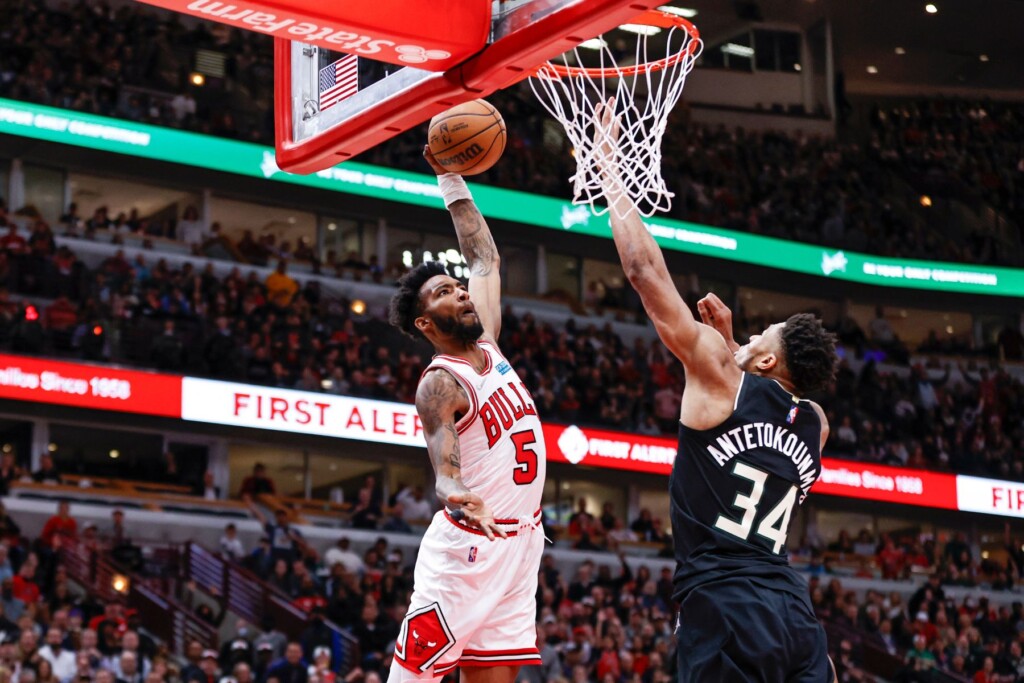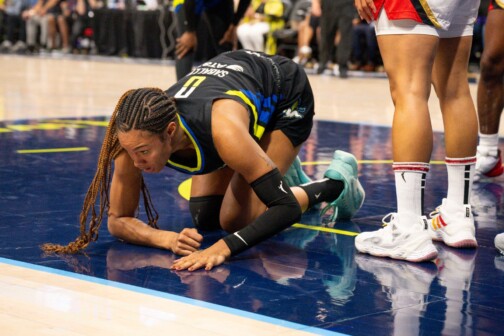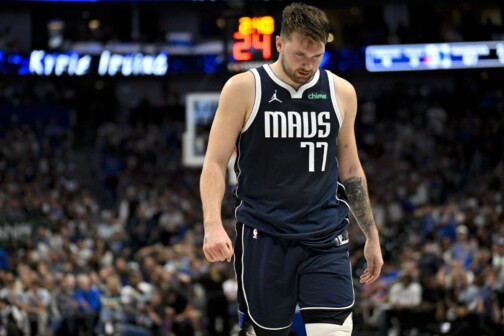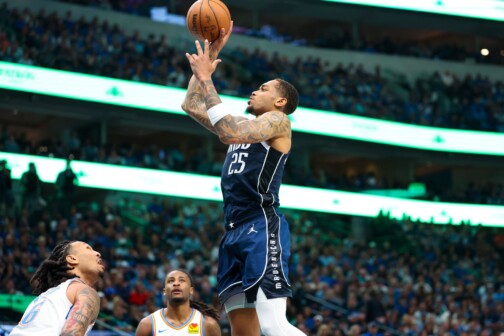You likely don’t have much of an opinion on Derrick Jones Jr., the 26-year-old wing whom the Mavericks signed to a one-year guaranteed deal to finish out the roster earlier this week. If you’re someone who does have one, it is probably of the skeptical variety. Populating the 15th roster spot with a player on a minimum contract doesn’t usually generate excitement, especially for fans who have grown accustomed to the team’s ongoing disregard for end-of-the-bench positions.
Part of why the Mavericks are where they are is because they haven’t gotten a ton right on the margins, and nowhere is that more evident than the back of the roster. Facundo Campazzo, Theo Pinson, Moses and Sterling Brown, Wesley Iwundu, James Johnson, Boban Marjanovic, Justin Jackson, Courtney Lee, Isaiah Roby, and Ryan Broekhoff stand out as names who have occupied the tail end of the rotation during the Luka Doncic era. A considerable number of them quickly departed the league after their stints in Dallas, or are on the path toward such an outcome.
The thing is, it hasn’t always been like this. Unearthing gems through minimum deals or under-the-radar transactions used to be the Mavericks’ calling card. Seasoned fans, particularly those who recall Dirk Nowizki’s teams in the late 2000s and early 2010s, will reminisce about fringe pickups like Brandon Bass, Brandan Wright, Al-Farouq Aminu, Delonte West, Antoine Wright, or even Raymond Felton. DeSagana Diop went from a Cavs lottery bust to a backup center on the 2005-2006 championship that nearly won the NBA title. Five years later, Ian Mahinmi followed a similar arc on the 2011 title team. Joining him in notable roles during that postseason run were Brian Cardinal (playing on his sixth NBA team), Corey Brewer (signed midseason after being waived by the Knicks), Peja Stojakovic (bought out by Toronto), and DeShawn Stevenson (a throw-in in the Caron Butler-Brendan Haywood deal who wound up being more pivotal than both). The Mavericks won that title in large part due to certain German entering the Hall of Fame this weekend. But every one of those margin calls played a part in helping Dirk Nowitzki win his long-awaited ring.
Winning those transactions alone won’t get Dallas back to the conference finals, or beyond. But uncovering players in the bargain bin is a key part of what my colleague Brian Dameris terms the “Miami template” that took the Heat from the play-in round to the NBA Finals. That is exactly the path the Mavericks need to tread. And after a prolonged period of missed opportunities on the roster fringes, they may have finally discovered a semblance of it in Jones.
This isn’t just due to the fact that the athletic 6-foot-6 forward is a former member of the Heat himself; he went unselected in the 2016 NBA draft before reviving his career on a two-way contract in South Florida. It’s because Jones holds the potential to bring numerous skills of which the Mavericks are in dire need.
Dallas entered the offseason with a goal to rejuvenate the roster, aiming to infuse athleticism, length, and defensive prowess. Bringing in the 2020 NBA Slam Dunk Contest champion, with his lengthy arms and an impressive 7-foot wingspan, undeniably checks the first two boxes.
But the 26-year-old’s remarkable athletic ability extends beyond mere highlight dunks, though it will be thrilling to witness Doncic deliver alley-oop passes to a player aptly nicknamed “Airplane Mode.” This athleticism translates to the domains where the Mavericks found themselves languishing at the bottom of the league last season: blocks, steals, and offensive rebounding. Jones’ 2.1 percent block rate stood out as one of the best among wing players last season, and he’s surpassed the impressive 2 percent threshold in four out of his seven career seasons. (He’s got at least one block on his ledger that’s as impressive as his dunks.) Likewise, his 7.4 percent offensive rebound rate placed him within the top five for forwards and wing players per Cleaning the Glass, and his team has been better on putbacks—another area where the Mavericks were awful last season; they ranked 29th in the league—when Jones is on the court throughout the majority of his career.
But there’s more to like about Jones’ defensive game than just his remarkable springiness. He’s also one of the NBA’s more versatile defenders, typically taking on the assignment of guarding the opposition’s top guard or wing player. According to tracking data from Second Spectrum, over the past two seasons he most frequently matched up against James Harden, Kevin Durant, and Jayson Tatum. He has defended All-Stars as varied in skill and size as Anthony Davis, Jaylen Brown, and Devin Booker. According to the same tracking data, Jones stands out as the lone player to have ranked within the top 30 in both pick-and-roll defense as a ball-handler defender (10th) and as a screener defender (27th) among those who defended more than 400 such possessions.
So, where’s the catch? Why was such a captivating defender available on a minimum deal at the tail end of free agency?
Because, as you may have guessed, Jones is a very limited offensive player. Some of his advanced metrics (such as usage rate, average touch length, and average dribbles taken) closely mirror those of Maxi Kleber and Reggie Bullock. That paints Jones as a player who rarely puts the ball on the floor and is frequently relegated to being the final option when his team has possession. But an even bigger issue arises from the fact that Jones doesn’t come close to matching the shooting proficiency of those two players; his career three-point percentage is a woeful 30 percent, although it bears mentioning that he shot 37 percent from the corners over the last two seasons. Opposing defenses largely ignore him—nearly 70 percent of his catch-and-shoot attempts occur without a defender contesting—and the fact that his defender often leaves Jones to roam and provide help complicates offensive spacing considerably.
The Mavericks would have encountered those same issues had they landed their primary free-agency target for a wing stopper, Portland’s Matisse Thybulle. (Dallas signed him to a multiyear deal in free-agency, only for the Blazers to match it and retain him.) Jones isn’t the defensive disruptor that Thybulle is—very few players are—but he brings a lot of those skills at a bargain price, and he does possess an offensive skill that ought to provide Mavericks fans with a glimmer of optimism, too. The best counter to Jones’ shooting limitations is to pair him with a dynamic on-ball creator and deploy him as the screener and vertical threat within the pick-and-roll play. And if there’s an ideal setting to maximize his exceptional rim-rolling abilities—Jones ranked as the second most efficient finisher as a roll man in the NBA last season—Dallas is it. Per Second Spectrum, Doncic is the most efficient ball handler over the past three seasons when the screener rolls to the rim. Stick him with an athletic player, send that player to the rim, and the lobs inevitably follow, be it to Christian Wood, Dwight Powell, or even the Slovenian national team’s Jordan Morgan. We know Jones has the requisite springs to fill that role in Dallas, and he’s got a track record of developing great pick-and-roll lob chemistry with another Slovenian point guard, Goran Dragic, during stints together in Chicago and Miami.
Jones and the Mavericks have one other thing going for them, too. Adding free-agent acquisition Grant Williams to Kleber gives them two big men capable of stretching the floor. This setup allows Jones to be the sole non-shooting threat who can be employed as a screener on offense and wing stopper on defense. Jones didn’t get that luxury in Chicago, where he spent most of his minutes alongside a traditional big like Nikola Vucevic or Andre Drummond. But the Bulls had a lot of success when they played small ball with Jones Jr. alongside former lottery pick Patrick Williams. Imagine a Powell who could defend wings. That’s what could be in play here.
This, of course, represents the most favorable outcome, one in which Jones not only secures a spot in the rotation but plays enough minutes to really contribute. I hold an affinity for exceptional athletes who can defend, which leads me to be more optimistic about Jones than many. But I harbored similar sentiments about Jarred Vanderbilt, who found his role minimized due to his declining shooting as the Lakers progressed, and the Mavericks’ comparable buy-low project in Frank Ntilikina. Both still played their part—recall that Ntilikina assumed Josh Green’s role as the primary defender against Booker off the bench during the Suns series in the 2022 playoffs—in their respective teams’ journey to the Western Conference Finals.
Even if Jones doesn’t work out, there’s one last positive aspect to this signing. It’s another step in a series of offseason moves—signing Williams, drafting two defensive-minded young prospects in Dereck Lively II and Olivier-Maxence Prosper, pursuing Thybulle, and acquiring Dante Exum—that underscore the front office’s dedication and introduces a breath of fresh air, ushering in a new approach to team construction centered around complementing Doncic and Kyrie Irving. Not all of them will hit like we hope, but stack enough players with a similar profile, and some of them will. This approach transforms even seemingly minor signings into opportunities. The Mavericks used to know a thing or two about that. Jones might be a sign that they’re relearning them.
Author







